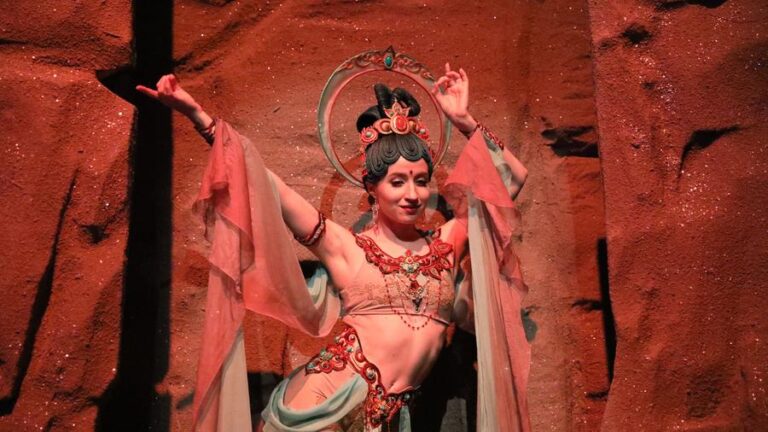* The reinterpretation of ancient Dunhuang culture has become a driving force behind the cultural and tourism boom.
* Last year alone, four classic performing arts attracted more than 1.14 million visitors to Dunhuang, with a record of over 2,000 performances.
* To manage the growing influx of tourists, the Dunhuang Academy has created a team of over 100 tour guides fluent in seven languages.
LANZHOU, Sept. 22 (Xinhua) — Ukrainian dancer Romanovych Inna has devoted herself to perfecting her posture, earning a regular role in the dance drama “Ancient Sound of Dunhuang,” now a cultural highlight in the northwestern Chinese city of Dunhuang, once a vital hub on the ancient Silk Road.
As the 8th Silk Road (Dunhuang) International Cultural Expo opened on Sunday, the small desert city with a population of around 200,000 welcomed guests and participants from 97 countries, who gathered for cultural dialogues, exhibitions and artistic performances.
“This historic city is a hot tourist destination. In such a peak season, we have 11 shows a day in the theater. It’s very tiring, but also very fulfilling,” said Inna, who portrays the roles of Bodhisattva and melody bird in the play.
The former ballet dancer has faced a challenging transition in mastering Dunhuang dance, a style that aims to bring to life the iconic figures depicted on the ancient murals of the Mogao Grottoes, which is a 1,600-year-old UNESCO World Heritage site in Dunhuang.
Despite her strong ballet background, Inna spent six months refining her movements to make her dance feel less “awkward” after she joined the cast a year ago. She visited the Mogao Caves twice and closely listened to the tour guides’ explanations to gain a deeper understanding of the art and culture within.
“There is a big difference between Dunhuang dance and ballet. The upper body of ballet is relatively straight and upright, while the movements of Dunhuang dance require the stretching and exaggeration of the upper body and soft finger posture, making it more difficult than ballet,” Inna said.
Since its premiere in June 2023, the dance drama has been performed more than 2,400 times, attracting over 860,000 audience members.
The reinterpretation of ancient Dunhuang culture has become a driving force behind the cultural and tourism boom. Drawing on historical themes, contemporary artists have created four awe-inspiring music and dance masterpieces, which also include the classic dance drama “Flower Rains Along Silk Road,” whose footprints have covered more than 40 countries and regions since its debut in 1979, and “the Thousand-Hand Bodhisattva” performed by dancers with hearing or visual impairment.
Last year alone, the four classic performing arts attracted more than 1.14 million visitors to Dunhuang, with a record of over 2,000 performances, according to data from the cultural and tourism department of Gansu Province. Through these cultural and visual feasts, tourists are immersed in the history of the ancient Silk Road, carrying forward Dunhuang’s ongoing journey of cultural preservation.
“Dunhuang not only has a profound historical heritage but also contains contemporary cultural vitality,” said Dai Bin, director of the China Tourism Academy. He noted that the city’s latest cultural tourism successes, such as the Dunhuang Book Center and Dunhuang Press, are inspiring more entrepreneurs to explore business opportunities rooted in the legacy of Dunhuang culture.
Speaking at the expo, Prasop Riangngoen, permanent secretary of the Ministry of Culture of the Kingdom of Thailand, said Dunhuang is a symbol of the Silk Road — an important hub where civilizations converge, ideas are exchanged and different arts are able to learn from each other.
As the guest of honor at the expo in Gansu Province, Thailand is showcasing its cultural heritage and ethnic customs.
“The artistic elements in the murals of the Mogao Caves share many similarities with the temple murals in Thailand, which fully demonstrates the close historical connection between the two countries,” Riangngoen said.
Angelo Mascheroni, an Italian PhD student in Tocharian studies, traced the origin of the ancient language to Dunhuang.
“I would be very pleased if I could purchase some nice volumes, like a Chinese edition of the manuscripts I studied, maybe some of the volumes I did not see in libraries in Europe. That would be amazing,” he said, explaining that the ancient language was spoken in the northwestern part of China.
To manage the growing influx of tourists, the Dunhuang Academy has created a team of over 100 tour guides fluent in seven languages, including Chinese, English and Japanese, who explain a millennium-long continuous history of chiselling caves and painting murals.
Vaja Bukia from Georgia, also a cast member of the dance drama “Ancient Sound of Dunhuang,” adapted the ancient Central Asian whirling dance movements depicted on the Mogao Cave murals, blending them with elements of traditional Georgian dance.
“The murals just left me in awe. They can display dynamic dance postures, featuring fast and powerful movements, which are somewhat similar to the Georgian dance. There are some rotating movements in the murals, and the gestures are not very convenient. I made a few changes to better suit my own performance,” he said.
Wang Qi, deputy director of marketing and promotion for the dance drama, said there are currently six foreign cast members. He added that the actors from Belt and Road countries help bring to life the cultural exchange and integration among the many ethnic groups along the ancient Silk Road. ■
(Video reporters: Zhou Yang, Ruan Shuai, Zhang Rui, Liu Keying, He Jin, Chen Qianci; video editors: Zhang Yucheng, Zhang Yuhong, Lin Lin)

